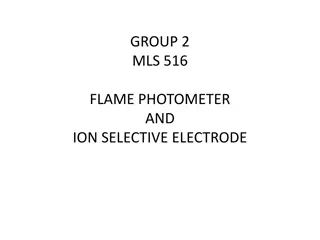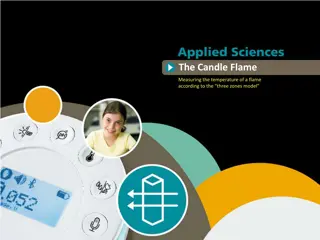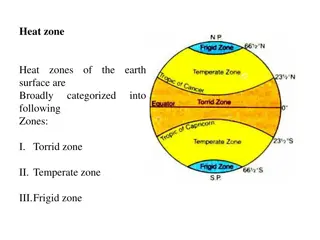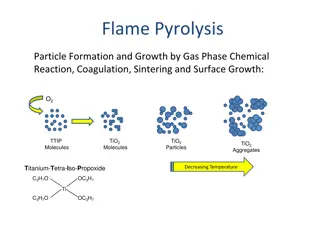Understanding Candle Flame Temperature through Color Zones Model
Explore the correlation between temperature and color in a candle flame using the three zones model. Learn how the different zones of a candle flame represent varying temperatures, from the blue basal region to the orange/brown incomplete combustion area. Conduct experiments to measure these temperature gradients and delve into the science behind the colors of a flame.
Download Presentation

Please find below an Image/Link to download the presentation.
The content on the website is provided AS IS for your information and personal use only. It may not be sold, licensed, or shared on other websites without obtaining consent from the author. Download presentation by click this link. If you encounter any issues during the download, it is possible that the publisher has removed the file from their server.
E N D
Presentation Transcript
The Candle Flame Measuring the temperature of a flame according to the three zones model
The Candle Flame Measuring the temperature of a flame according to the three zones model Objective The purpose of this activity is to relate temperature and color in a candle flame, create a hypothesis and proceed to test it using the Labidsc thermocouple sensor.
The Candle Flame Measuring the temperature of a flame according to the three zones model Introduction and theory Different materials change their appearance because of environmental influences. Heat is one of the most common environmental factors and it produces an easily recognizable change of color in matter when temperature is increased. An example of this phenomenon can be found in the metal industry where metals show a bright yellow color just before melting which is called incandescence. It is therefore clear that not only can we relate color to the temperature of matter, but also to its intensity.
The Candle Flame Measuring the temperature of a flame according to the three zones model Introduction and theory Why do you think we call some colors warm or cold? Think of examples. Have you ever seen the different colors of a candle flame? Have you felt the irradiated heat from the flame? According to what we ve discussed so far, a simple candle flame can make an interesting scientific study object and in this experiment we ll try to discover all its complexity. Carry out the experiment activity with your class so that at the end you ll be able to answer the following question: Are the colors of a flame related to the temperature gradient along it?
The Candle Flame Measuring the temperature of a flame according to the three zones model Introduction and theory Theoretical A candle flame is produced by the combustion of wax, a hydrocarbon. Once the candle has been lit, the heat melts the wax which rises through the wick by capillarity and is vaporized. The color gradient reveals the temperature increase from the base to the top of the flame, similar to the ignition of a metal. In this case, elemental carbon particles called soot are released from the incomplete combustion of the wax and are heated by the exothermic energy of this reaction thus emitting light.
The Candle Flame Measuring the temperature of a flame according to the three zones model Introduction and theory The flame of a candle has a structure comprised of three areas, showing colors near to the infrared spectrum the higher the temperature is: Blue area: Basal region of the flame where combustion is complete due to the richness of oxygen. Carbon particles are not present here. Orange/brown area: The majority of oxygen is consumed in the blue area, therefore the combustion here is incomplete. Because of that, we can find a great concentration of carbon which is heated to temperatures ranging from 800 to 900 C. Yellow area: The chemical conditions here are similar to the previous area; however the carbon particles have now reached higher temperatures.
The Candle Flame Measuring the temperature of a flame according to the three zones model Introduction and theory Now students are encouraged to raise a hypothesis which must be tested with an experiment. If you measure the temperature of different areas of a candle flame, how do you expect the results to change when you measure from the lowest to the highest zone? Why?
The Candle Flame Measuring the temperature of a flame according to the three zones model Activity description Students will study the relationship between the chromatic structure of a candle flame and the temperature of each area, calculating the magnitude differences quantitatively. They will use tools for graph analysis to find out the results.
The Candle Flame Measuring the temperature of a flame according to the three zones model Resources and materials 3 Labdisc Thermocouple Candle Matches 1 1 2 3 2 4
The Candle Flame Measuring the temperature of a flame according to the three zones model Using the Labdisc Labdisc configuration To collect measurements with the Labdisc and thermocouple sensor, the Labdisc must be configured according to the following steps: Open the GlobiLab software and turn on the Labdisc 1 Click on the Bluetooth icon in the bottom right corner of the GlobiLab screen. Select the Labdisc you are using currently. Once the Labdisc has been recognized by the software, the icon will change from a grey to blue color . If you prefer a USB connection follow the previous instruction clicking on the USB icon. You will see the same color change when the Labdisc is recognized . 2
The Candle Flame Measuring the temperature of a flame according to the three zones model Using the Labdisc 3 Click on to configure the Labdisc. Select thermocouple in the Logger Setup window. Enter 10/s for the sampling rate.
The Candle Flame Measuring the temperature of a flame according to the three zones model Using the Labdisc 4 Once you have finished the sensor configuration, and completed the experiment setup - start measuring by clicking 5 Once you have finished measuring stop the Labdisc by clicking
The Candle Flame Measuring the temperature of a flame according to the three zones model Experiment Light a candle and wait one to two minutes. After this period throw away the liquid wax and measure the flame height. 1 2 Identify the three separate areas in the flame. Start by inserting the Thermocouple sensor tip into the blue zone, pull out the sensor and insert it to the orange and then to the yellow zones.
The Candle Flame Measuring the temperature of a flame according to the three zones model Experiment As you introduce the thermocouple to each of the three areas of the flame, make sure the thermocouple tip is soot-free. 3 Be careful: The thermocouple isolation is easily burnt when it is close to fire. 4 Once you have finished measuring stop the Labdisc
The Candle Flame Measuring the temperature of a flame according to the three zones model Results and analysis 1 Add text annotations and pictures to the temperature reading of each flame zone by clicking . Get the average, maximum and minimum values of temperature using the statistics tool from the menu and calculate the difference between the 2 extreme temperatures. 3 Observe the table data by placing markers and dragging them between the 3 different readings.
The Candle Flame Measuring the temperature of a flame according to the three zones model Results and analysis How do the results relate to your initial hypothesis? Explain. What was the relationship between the color and temperature of the flame? Where did you record the minimum and maximum temperature values? What was the average between these magnitudes? Was the average similar to the temperature in the second area (orange/brown)? What was the magnitude of temperature range within the flame height? Did you expect this result?
The Candle Flame Measuring the temperature of a flame according to the three zones model Results and analysis The graph below should be similar to the one the students came up with:
The Candle Flame Measuring the temperature of a flame according to the three zones model Conclusion What variables are correlated in this experiment? Students should point out that the temperature increase is related to the spectral scale, namely warmer colors show the higher temperatures. Indirectly, the height of the flame could also be correlated with the temperature. Why is the basal area of the flame blue? Students should mainly consider two reasons: This area has the higher oxygen concentration since it is the starting point of the gas that determines the complete combustion. As a result the amount of carbon is not meaningful and therefore the ignition is practically nothing.
The Candle Flame Measuring the temperature of a flame according to the three zones model Conclusion How are warm colors produced in the upper and middle areas of the flame? Students should remember from the theoretical background that the carbon particles are heated by the exothermic energy. The carbon then becomes incandescent and emits light near to the infrared spectrum.
The Candle Flame Measuring the temperature of a flame according to the three zones model Activities for further application In what position should the ring of a Bunsen burner be located to heat a beaker with the least amount of soot? Why? Students should point out that the most important condition is to allow the greatest possible amount of oxygen to enter. In this way a complete combustion reaction is reached which produces a low soot concentration. If you wanted to know the approximate mean temperature of a steel nail heated at its tip, what zone would you measure? Students should use the knowledge obtained during the class to suggest they could get an approximate value in the middle zone of the nail.























